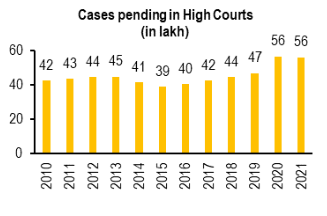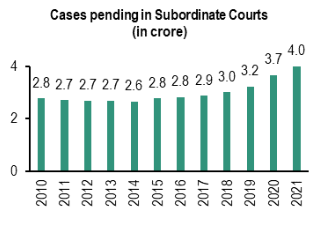
Online dispute resolution is the latest innovation in the field of alternative dispute resolution. Ever since the Covid-19 Pandemic broke out, this new concept has evolved at a fast pace. The Indian judiciary has been instrumental in digitalising the legal system to a major extent when it initiated the online mode for legal proceedings. Even the government and government bodies have been promoting ODR since there are more than 4.27 crore cases pending before courts in India.
In 2021, NITI Aayog issued a comprehensive policy on online dispute resolution in India, laying out clear objectives of the government to promote ODR as this can potentially reduce the case burden on Indian courts and provide quicker access to justice. The report analyses the present status of ODR in India and anticipates what the future holds for ODR. It eventually makes recommendations to combat the current challenges to make India an international hub for alternative dispute resolution.
READ I E-commerce exports: India can borrow from China, Japan playbooks
What is online dispute resolution
Online dispute resolution is a breakthrough in the arena of dispute resolution across different sectors including finance and e-commerce. According to the 2017 UNCITRAL Technical Notes, “ODR is a mechanism for resolving disputes through the use of electronic communications and other information and communication technology.” In other words, ODR is a process to settle disputes outside courts, combining technology and alternative dispute resolution (ADR) mechanisms.
ODR covers disputes that are settled over the internet having been initiated in cyberspace but with a source outside it i.e., offline. ODR offers a faster, transparent, cost-effective and accessible option for many companies to resolve disputes online, particularly those who have high volume and low-value cases. In the last five years, India has seen significant growth in the volume of online transactions. It would be convenient to accept ODR as a mechanism to resolve disputes and implement a fast and fair dispute resolution system.
READ I India leads in digital public goods, but needs to bridge digital divide
The methods of ODR
ODR mechanisms are a combination of synchronous and asynchronous methods of communication. The combination of synchronous ODR is a method of dispute resolution where the parties communicate with each other in real-time by using various video-conferencing applications, whereas asynchronous form is where communication is not conducted in real-time but via email or other such communication applications.
ODR mechanisms include e-mediation, e-conciliation, e-negotiation and e-arbitration. The parties are free to choose the appropriate mechanism to resolve their disputes according to the nature of the dispute. Every practicable method of ODR is unique and efficient to itself and the beauty is that it can be tailored as per the needs of the parties.
ADR vs ODR
ODR is often confused with or seen as simply an online form of ADR. It must be noted that ODR is not ADR. This is because ODR is a distinct form of dispute resolution on its own. The foregoing is however, not a denial of the fact that ODR has its roots in face-to-face disputes. You can understand that ODR and ADR exist in a continuum with each method of resolving disputes maintaining its distinct status or personality.
ADR is a primitive concept while ODR is an innovation in the 21st century that complements latest technological advancements. Today every sector of the world’s economy has been taken over by the electronic revolution coupled with the tech-savvy nature of the populace, specifically the youths, such that if a sector fails to catch up, it is left behind. The trends now are electronic transactions, e-banking, e-commerce, crypto currency, financial technology etc. Fortunately, dispute resolution has grown beyond the four walls of a room and emerged in the form of ODR.
ODR platforms in India
There has been a shift in the pattern of resolving disputes as many ODR platforms have been established in the country, facilitating particular kinds of dispute resolution for many national and international companies. These ODR platforms have made easy the process of dispute resolution by combining the already existing process of ADR with cutting-edge technology, making the process feasible and time convenient and cost-effective.
The Government has time and again emphasized the significance and role of private ODR service providers. The Niti Aayog report on ODR observes that “Given that the private sector is seeing a growth in India, it is recommended that the services of the private sector be utilised wherever possible during these early stages of innovation.”



In India, ODR is still in its infancy stage, but it is just a matter of time before ODR is adopted at a large scale in India. With 4.5 million cases pending in high courts, 31 million in district courts and 350,000 in the 5 central tribunals, we are in need of ODR platforms to come up to the rescue. ODR mechanism is simple and effective and thus carry a huge potential to become the mainstream dispute resolution system, the acceptance of which cannot be called into question.
According to the National Centre for Technology and Dispute Resolution, the use of ODR will play a major role in easing the burden of courts. According to the latest data, more than 3,600,000 cases in India have been resolved through ODR since 2020. The private ODR institutions are instrumental in making ODR processes accessible to parties. This will generate a large number of employment opportunities to arbitrators, mediators and advocates.
(Navneet Sharma is Director General at CUTS International and Kritika Sethi is Co-Founder at WeVaad. The views are personal.)
